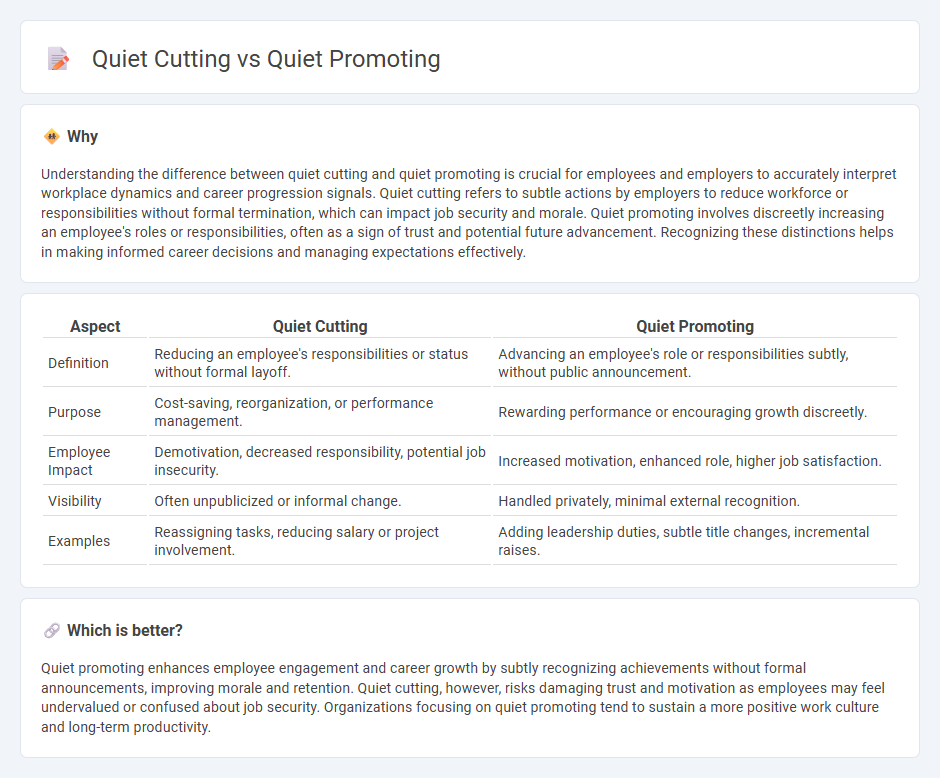
Quiet cutting refers to the subtle reduction of an employee's responsibilities or work hours without formal termination, often leaving workers uncertain about their job status. Quiet promoting involves increasing an employee's responsibilities or authority discreetly, sometimes without immediate official acknowledgment. Explore more about how these contrasting employment strategies impact workplace dynamics and career growth.
Why it is important
Understanding the difference between quiet cutting and quiet promoting is crucial for employees and employers to accurately interpret workplace dynamics and career progression signals. Quiet cutting refers to subtle actions by employers to reduce workforce or responsibilities without formal termination, which can impact job security and morale. Quiet promoting involves discreetly increasing an employee's roles or responsibilities, often as a sign of trust and potential future advancement. Recognizing these distinctions helps in making informed career decisions and managing expectations effectively.
Comparison Table
| Aspect | Quiet Cutting | Quiet Promoting |
|---|---|---|
| Definition | Reducing an employee's responsibilities or status without formal layoff. | Advancing an employee's role or responsibilities subtly, without public announcement. |
| Purpose | Cost-saving, reorganization, or performance management. | Rewarding performance or encouraging growth discreetly. |
| Employee Impact | Demotivation, decreased responsibility, potential job insecurity. | Increased motivation, enhanced role, higher job satisfaction. |
| Visibility | Often unpublicized or informal change. | Handled privately, minimal external recognition. |
| Examples | Reassigning tasks, reducing salary or project involvement. | Adding leadership duties, subtle title changes, incremental raises. |
Which is better?
Quiet promoting enhances employee engagement and career growth by subtly recognizing achievements without formal announcements, improving morale and retention. Quiet cutting, however, risks damaging trust and motivation as employees may feel undervalued or confused about job security. Organizations focusing on quiet promoting tend to sustain a more positive work culture and long-term productivity.
Connection
Quiet cutting and quiet promoting both involve subtle workforce management strategies impacting employee morale and retention. Quiet cutting typically refers to reducing employee benefits or workload without clear communication, leading to disengagement. Quiet promoting, in contrast, recognizes and elevates employees discreetly, fostering loyalty and motivation despite limited formal announcements.
Key Terms
Underemployment
Quiet promoting involves subtly advancing employees without formal announcements, often leading to increased responsibilities but not necessarily higher salaries, which can contribute to underemployment. Quiet cutting, on the other hand, refers to reducing employee benefits or work hours discreetly, effectively diminishing job quality while maintaining official employment status. Explore how these hidden workforce strategies impact underemployment rates and employee well-being.
Job responsibilities
Quiet promoting involves subtly highlighting an employee's achievements and expanding their job responsibilities without formal announcements, fostering organic career growth. Quiet cutting entails reducing workloads or responsibilities discreetly to manage costs or performance issues without triggering formal disputes. Explore effective strategies to balance quiet promoting and quiet cutting in workforce management.
Workforce reduction
Quiet promoting emphasizes discreetly advancing employees without public announcements, fostering internal morale and retention during workforce reduction phases. Quiet cutting involves subtle layoffs or role eliminations to streamline operations while minimizing disruption and negative publicity. Explore strategies to balance effective workforce reduction with employee engagement and organizational resilience.
Source and External Links
Quiet promoting: A silent workplace menace - Outsource Accelerator - Quiet promoting refers to the practice of giving employees additional responsibilities without a promotion or pay raise, leading to feelings of neglect and decreased employee engagement, with 78% of workers reporting experiencing it, especially in industries like art, hospitality, and food services.
The Quiet Movement Lives on with Quiet Promotions - Quiet promoting is an increasingly recognized trend where workers are assigned more work and higher-level duties without pay or title increases, with surveys showing many employees feel manipulated or exploited under this practice.
Quiet Promoting and What You Can Do About It - The Muse - Quiet promoting is described as an old workplace issue gaining a new label, where employees take on more tasks at a higher level but do not receive commensurate raises or promotions, contributing to dissatisfaction and burnout.
 dowidth.com
dowidth.com